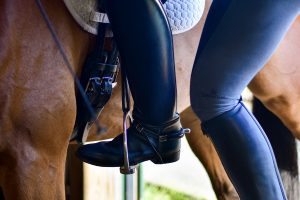1. Riding corners. It’s so easy at home to get just a little lazy about corners, and that’s an expensive mistake. Because then when you start putting tests together, surprise! There are corners in those! And even just in regular schooling, corners are where all the prep lives for your lateral work, for your turns, for your transitions. Corners are where the magic happens, and when they become a habit, they require less conscious thought when the chips are down.

2. Practicing good mounting block etiquette. We’ve all been there, right? Our left foot is in, we start to swing over, and our horse starts to meander off. Do you stop and fix it, or do you just let it slide, just this once? “Just this once” quickly becomes a habit, and it’s not a great one. What if you ever have a sore back, or a bum ankle, and you need to take a minute to mount that your horse isn’t going to give you? What if you lose your balance and your horse is already on his way out from underneath you? Or what if you ever want to sell your horse to someone who requires that their horse stand perfectly still? This is an easy thing to practice and make a good habit, and it also sets your ride off from the right foot, one where your horse patiently awaits further instructions, instead of calling shots on his own.
Want the easiest way to fix this? Keep a treat in your pocket. Horsey doesn’t get said treat unless he’s immobile. It’ll fix it right quick (though sometimes EDDIE I’M LOOKING AT YOU you’ll create a monster who likes to swing his head around to your boot while mounting. But then I just give him the treat from the other side. They’re fortunately not all that hard to outfox.)
3. Letting your aids go to 0. I promise you that you are not taking your leg off enough. And I can similarly promise you that you’re not giving the reins enough. Überstreichen – the German word for the act of putting slack in the reins for a stride or two by straightening the rider’s elbow – is a a beautiful thing, and a test of your horse’s self carriage. Your horse should maintain his own balance and posture for the strides of the release. It also allows the rider to retake less contact than they had before, by resetting the contact to zero.
Ditto taking the leg off. Remove it altogether, from the hip, once in a while. Your horse should maintain the same posture, gait and energy level without your leg as with it, and will allow you to do more from less leg once you put it back on. Work smarter, not harder, my friends. It’ll save you money on bits and spurs, not to mention being, you know, good riding.
4. Cleaning your buckles and stitching. Bridles and girths are the big offenders here, and I know how easy it is to just pop a little tack soap on a sponge and wipe things down. But you need to get into buckles, including undoing them, cleaning, and redoing them. Same story with the stitching on your leatherwork, especially high-sweat things like riding boots and girths. Get in there with your tack soap, and get hair out with a hoof pick or stiff brush. Dirt, sweat and moldy hair can break down your stitching over time, and nothing says fun like breaking a girth while riding. Take the time.
5. Replacing your helmet. Many – though certainly not most! – of us are good about replacing helmets after a fall, even if you don’t see any damage to the hat. But did you know that helmets have a lifespan, even if they haven’t had any trauma? The foam and other materials inside helmets do break down, and so it’s recommended that you replace your helmet every 4-5 years, no matter what, and possibly more often if you, like me, are in your helmet for hours a day.
Here’s a great article from my friends at OneK about the whys and wherefores of helmet replacement. And if you’re reading this going “Uh oh, I’m guilty!” then your timing is impeccable, because Helmet Awareness Day is upon us! There’s usually lots of great sales on OneK helmets that weekend, including my favorite, the Avance CCS, which features their cool color change system, a wide brim for sun protection, and the absolutely-critical MIPS safety functionality, which helps protect your brain from shearing forces better than a traditional helmet.
Like Snippets? Sign up for the Sprieser Sporthorse Elite Club, where you’ll get even more monthly goodies, training tips, and a peek behind the scenes in the development of horses from foal to FEI. Click to learn more!